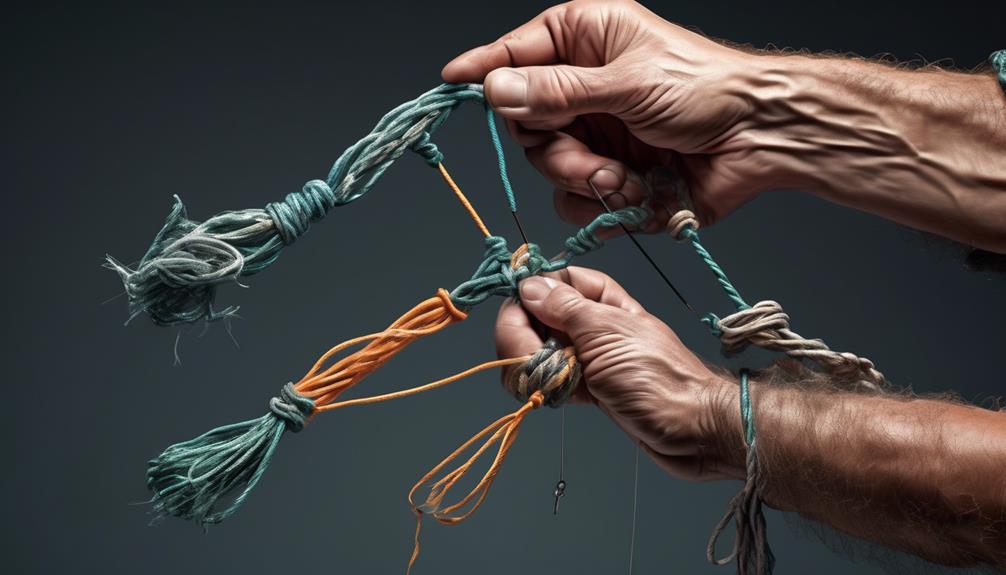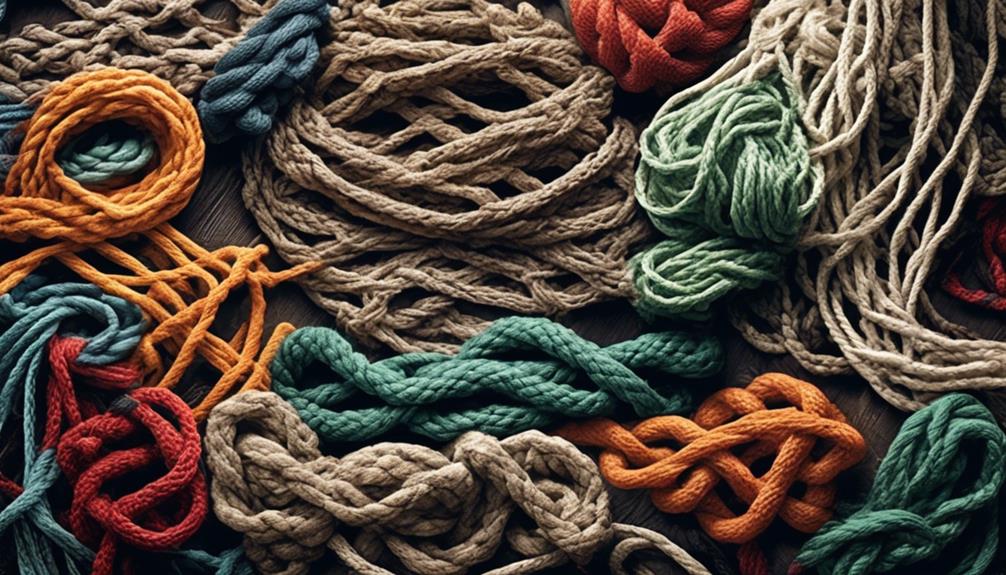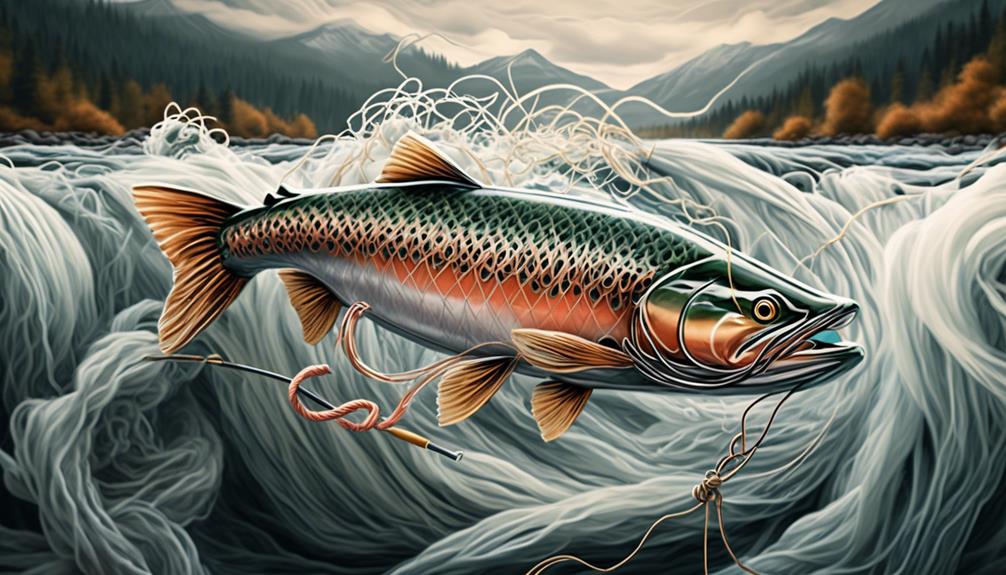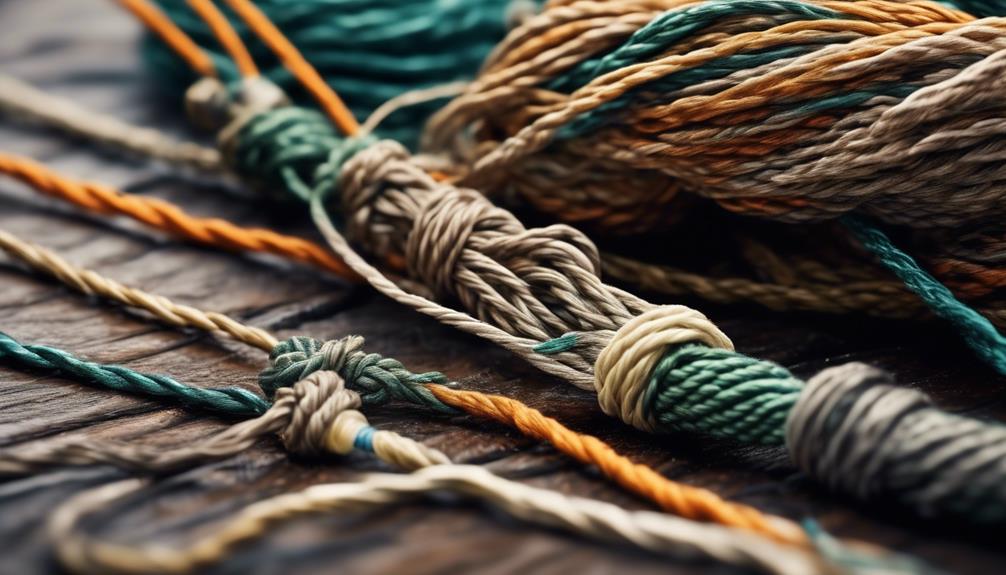Whether you're an experienced angler or just starting out, mastering a few fast-tying knots can make your fishing trips a lot more efficient. There's nothing worse than struggling with a stubborn knot when you're trying to get your line in the water.
But fear not, because we've got three quick and easy knots that will save you time and frustration on the water. These knots are the key to smoothly transitioning from one catch to the next, and they might just be the secret to your next big haul.
Palomar Knot
The Palomar Knot is a popular choice for securing fishing line to a hook or lure due to its simplicity and reliability. Its strength and versatility make it suitable for various fishing applications.
When tying the Palomar Knot, it's essential to ensure that the hook or lure is passed through the loop before cinching it tight. This straightforward yet essential step ensures the knot's integrity and reduces the likelihood of slippage. Additionally, moistening the knot before tightening it's a key tying tip that enhances its strength and reduces friction, preventing damage to the line.
The Palomar Knot's strength is particularly advantageous when targeting larger or stronger fish species. Its double-line design distributes the pressure evenly, minimizing the risk of breakage when battling powerful fish. This knot's versatility further extends to different types of fishing lines, including monofilament, fluorocarbon, and braided lines. Whether you're casting for bass in freshwater or targeting snapper in saltwater, the Palomar Knot provides a reliable connection between your line and the hook or lure.
Improved Clinch Knot
Consider moistening the fishing line before tying the Improved Clinch Knot to enhance its strength and reduce friction. This simple yet strong knot is a popular choice among anglers due to its reliability and ease of tying.
To maximize the knot strength, ensure that the tag end of the line is trimmed close to the knot after cinching it tight. This prevents any excess line from interfering with the knot's integrity.
When tying the Improved Clinch Knot, remember to make a minimum of five turns around the line before threading the tag end back through the loop formed near the eye of the hook or lure. This increases the knot's ability to withstand the forces encountered during fishing.
To master knot tying techniques, practice is key. Familiarize yourself with the steps required to tie the Improved Clinch Knot until it becomes second nature. This will help you tie the knot quickly and efficiently, even in low-light conditions or when dealing with cold or wet hands.
Additionally, understanding the mechanics of the knot will give you confidence in its reliability, allowing you to focus on the fishing experience without worrying about potential knot slippage or breakage.
Rapala Knot
To tie the Rapala Knot effectively, moistening the fishing line can aid in reducing friction and increasing the strength of the knot. This knot is particularly useful for attaching a lure to the fishing line and is known for its strength and reliability.
Here are some tips to help you master the Rapala Knot:
- Proper Wrapping: Start by passing the tag end through the lure's eye and then back through it in the opposite direction. Ensure that you make at least six turns around the standing line before passing the tag end through the loop near the eye.
- Moistening the Line: Before tightening the knot, moisten the line with saliva or water. This simple step reduces friction and allows the knot to cinch smoothly, enhancing its overall strength.
- Careful Tightening: Once you have passed the tag end through the loop, ensure that you tighten the knot gradually and evenly. This will help to maintain the knot's integrity and maximize its strength.
Non-Slip Loop Knot
For securing lures or hooks, the non-slip loop knot is a reliable and straightforward option. Its knot strength and versatility make it a popular choice among anglers. The non-slip loop knot is known for its ability to maintain a high level of knot strength, ensuring that your lure or hook remains securely fastened during the most rigorous fishing activities. This knot is particularly useful when using artificial lures or fishing with braided lines, where maintaining knot strength is crucial.
One of the key advantages of the non-slip loop knot is its versatility. Whether you're casting for bass in freshwater or targeting saltwater species like snook or redfish, this knot can adapt to various fishing scenarios. Its versatility also extends to the types of lures or hooks it can secure, making it a go-to option for many anglers who use different setups for different fishing conditions.
When tying the non-slip loop knot, ensure that the tag end is long enough to make several wraps around the standing line. This will help maximize the knot strength and prevent slippage. Additionally, always moisten the knot before tightening to reduce friction and prevent damage to the line.
Double Uni Knot
When securing your lures or hooks, the non-slip loop knot is a reliable option.
Now, let's move on to discussing the Double Uni Knot. This knot is highly versatile and can be used to join lines of different materials and diameters.
Here are some key points to consider when using the Double Uni Knot:
- Line Strength: The Double Uni Knot is known for its ability to maintain a high percentage of the line's original strength. This is crucial when targeting larger fish or fishing in areas with heavy cover where strong, reliable knots are essential.
- Knot Efficiency: One of the main advantages of the Double Uni Knot is its efficiency. It's relatively easy to tie and can be quickly mastered with a bit of practice. This knot is especially useful when you need to join lines of different diameters, making it a go-to choice for anglers seeking versatility in their fishing setups.
- Adaptability: Whether you're using monofilament, fluorocarbon, or braided lines, the Double Uni Knot is suitable for various types of fishing lines. Its adaptability adds to its appeal, allowing anglers to use it across a wide range of fishing scenarios.
San Diego Jam Knot
Master the San Diego Jam Knot for a reliable and secure connection when fishing in diverse conditions. This knot is known for its exceptional knot strength, making it a go-to choice for anglers who need a robust connection. It's particularly useful when dealing with braided lines, as it maintains impressive knot strength even with these slippery and smooth lines. The San Diego Jam Knot is versatile and can be used with various types of fishing lines, including monofilament, fluorocarbon, and braided lines. Its simplicity and effectiveness make it a valuable skill for any angler.
When tying the San Diego Jam Knot, ensure that the tag end runs parallel to the standing line. This is crucial for maximizing knot strength. The friction-based design of the knot provides excellent security, so you can trust it to hold strong under pressure. This knot is especially popular among saltwater anglers due to its reliability when battling strong and aggressive fish species.
Whether you're targeting large game fish or enjoying a day of freshwater angling, the San Diego Jam Knot's compatibility with various fishing lines makes it a versatile and valuable addition to your knot repertoire. With its exceptional knot strength and compatibility with different lines, mastering the San Diego Jam Knot will undoubtedly enhance your fishing experience.
Albright Special Knot
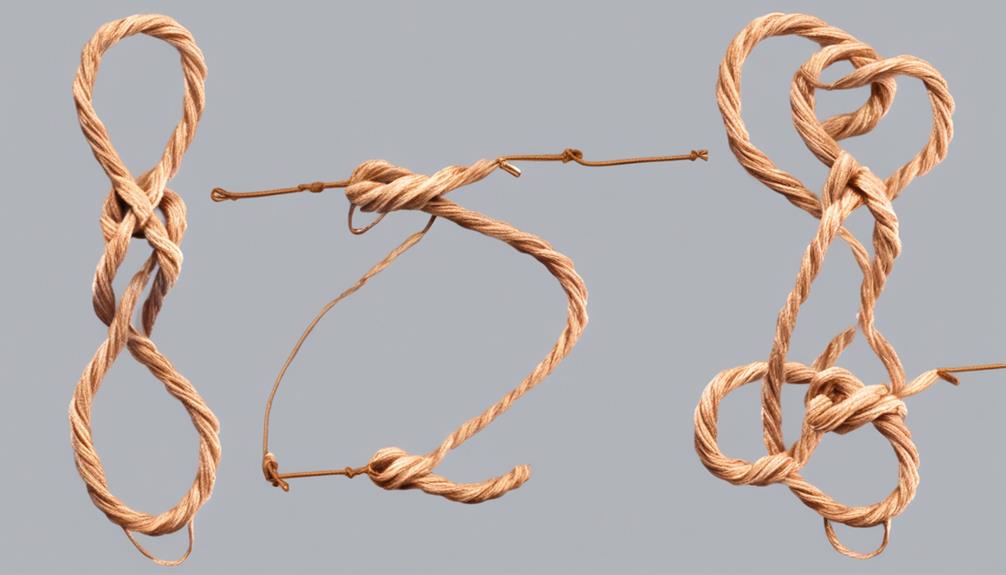
To connect different types of fishing line, you can rely on the Albright Special Knot for a secure and durable bond. This knot is highly versatile and is commonly used to join lines of different materials and diameters. Here are some key points to consider when using the Albright Special Knot:
- Knot Strength: The Albright Special Knot is known for its exceptional strength. It creates a smooth and streamlined connection between lines, ensuring that the knot can withstand the intense pressure of battling large fish.
- Knot Reliability: Anglers favor the Albright Special Knot for its reliability. When tied correctly, this knot maintains its integrity, reducing the likelihood of slippage or failure, even when dealing with aggressive game fish.
- Knot Application: This knot is well-suited for connecting monofilament, fluorocarbon, or braided lines to leaders or mainlines. Its ability to seamlessly join lines of varying diameters makes it a valuable knot for various fishing scenarios.
The Albright Special Knot also offers several variations, allowing anglers to adapt it to specific fishing conditions or preferences. These variations may involve adjustments to the number of wraps or the finishing technique. Understanding these variations can further enhance the knot's utility in different fishing situations.
Dropper Loop Knot
If you're looking to expand your repertoire of fishing knots, the Dropper Loop Knot is a valuable addition, complementing the versatility of the Albright Special Knot for connecting lines in various fishing scenarios. The Dropper Loop Knot is particularly useful for creating a loop off the main line, allowing you to attach additional lines or hooks, making it an excellent choice for multi-hook fishing rigs. Its applications are diverse, as it can be used for bottom fishing, trolling, or even fly fishing, making it an essential knot for anglers who need flexibility in their setups.
One of the key advantages of the Dropper Loop Knot is its ability to create a strong and reliable loop without compromising the integrity of the main line. This makes it ideal for situations where you need to attach additional bait or lures without weakening the primary line. Additionally, the knot is relatively easy to tie, making it accessible to anglers of all skill levels. Its simplicity is further enhanced by the fact that it can be tied in various line types, including monofilament, fluorocarbon, and braided lines.
When it comes to tying techniques, there are several variations of the Dropper Loop Knot, each with its own advantages depending on the specific fishing scenario. Whether you're looking to create a fixed or sliding loop, there's a tying technique that suits your needs. Experimenting with these variations can help you find the most effective way to incorporate the Dropper Loop Knot into your fishing arsenal.
Frequently Asked Questions
What Are the Best Types of Fishing Lines to Use With Each of These Knots?
When choosing the best fishing lines for these knots, consider knot compatibility and fishing line selection.
The knot effectiveness is influenced by fishing line types, such as monofilament, fluorocarbon, and braided lines.
For the three fast-tying knots, you may find that certain fishing lines work better due to their thickness and flexibility.
Experiment with different lines to find the best fit for each knot.
Can These Knots Be Used for Saltwater Fishing as Well as Freshwater Fishing?
Yes, you can use these knots for both saltwater and freshwater fishing. They're versatile and efficient for various fishing techniques in different environments.
These knots are great for saving time and effort, especially when using knot tying tools. Whether you're fishing in the ocean or a freshwater lake, these fast-untying knots will help you streamline your fishing process and adapt to different fishing conditions.
Are There Any Specific Types of Fish That Each Knot Is Particularly Effective for Catching?
When it comes to fishing, the specific fish species can determine the effectiveness of each knot. Certain knots are particularly effective for catching specific types of fish. Mastering different knot tying techniques can greatly improve your fishing success.
Understanding which knots work best for different fish species can make a significant difference in your fishing experience. Learning about the specific types of fish and the knots that work best for them can lead to greater fishing success.
How Do You Properly Test the Strength and Reliability of These Knots Before Using Them While Fishing?
Before using knots for fishing, it's crucial to test their strength and reliability. You can do this by pulling the knot tight and examining it for any signs of weakness or slippage. Additionally, you can apply steady pressure to see if the knot holds.
It's also essential to practice tying the knots multiple times to ensure you're comfortable with the technique. These steps will help you have confidence in your knots while fishing.
Are There Any Variations or Modifications of These Knots That Can Be Used for Specific Fishing Situations or Conditions?
When fishing, modifications of knots can be useful for specific conditions. To ensure reliability, test the strength and reliability of these knots before using them.
Consider variations for different applications, such as adjusting knots for different types of fishing lines or environmental conditions. This testing helps ensure the knots will hold under the specific circumstances you'll encounter while fishing.
Conclusion
Now that you've learned these fast-tying knots for efficient fishing, you can spend less time struggling with your line and more time reeling in the big catch.
Practice these knots until they become second nature, and you'll be ready for any fishing situation that comes your way.
Happy fishing!
